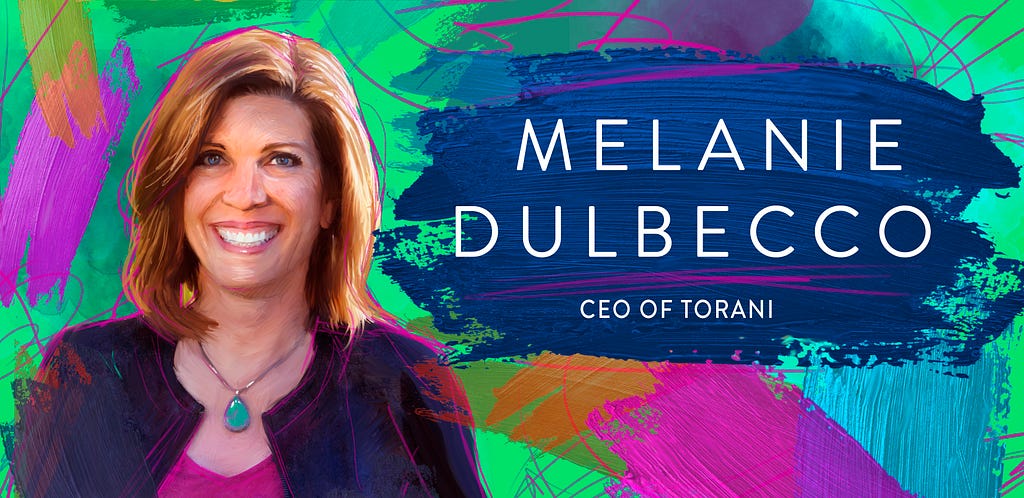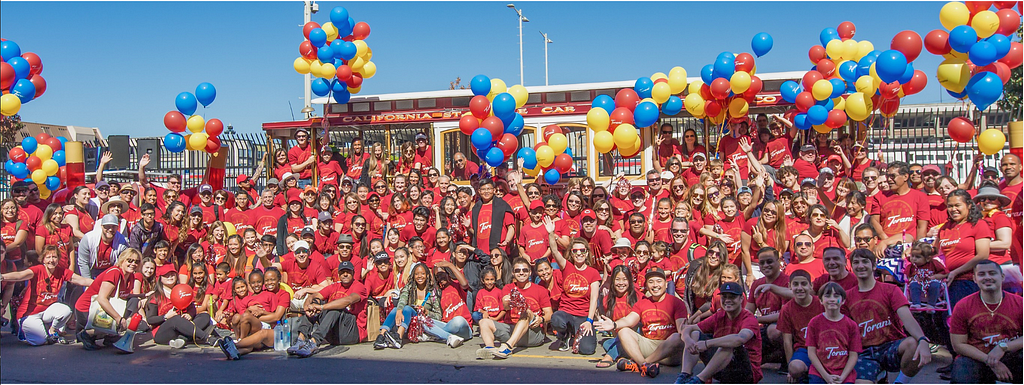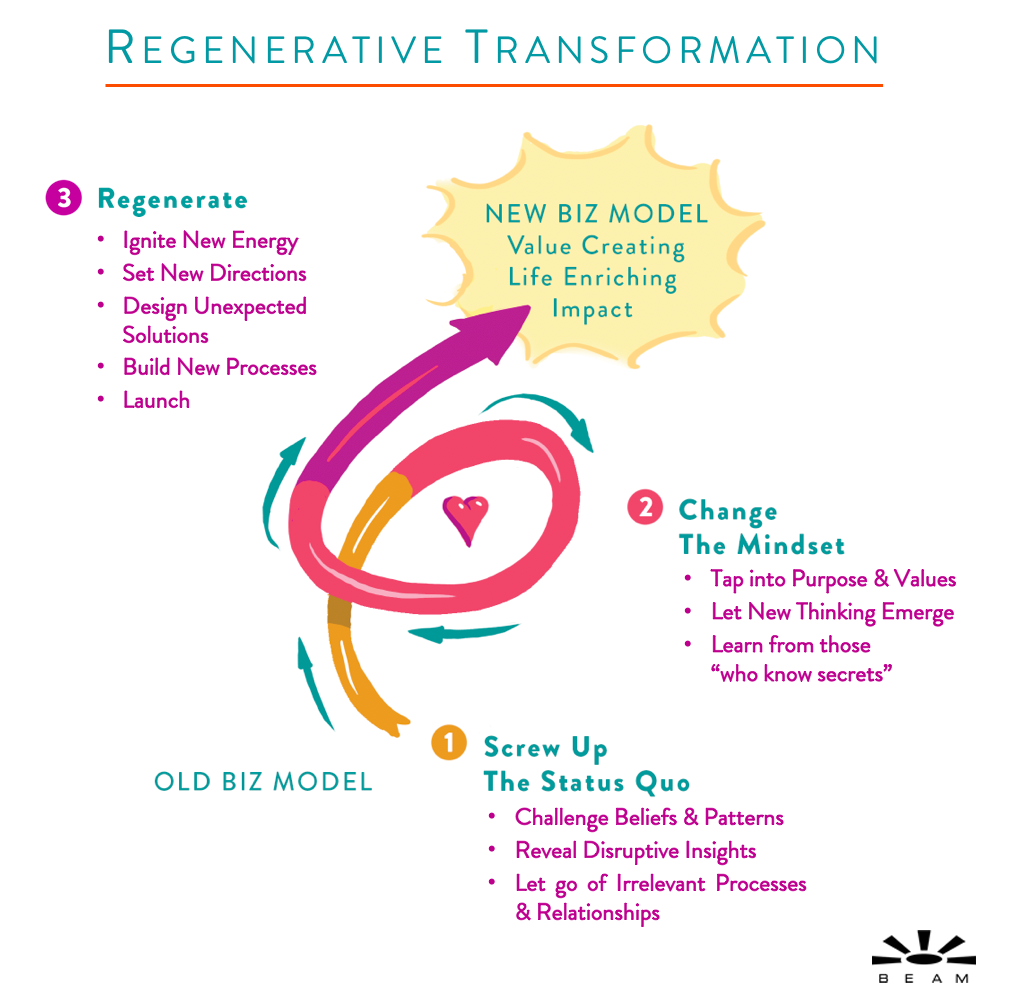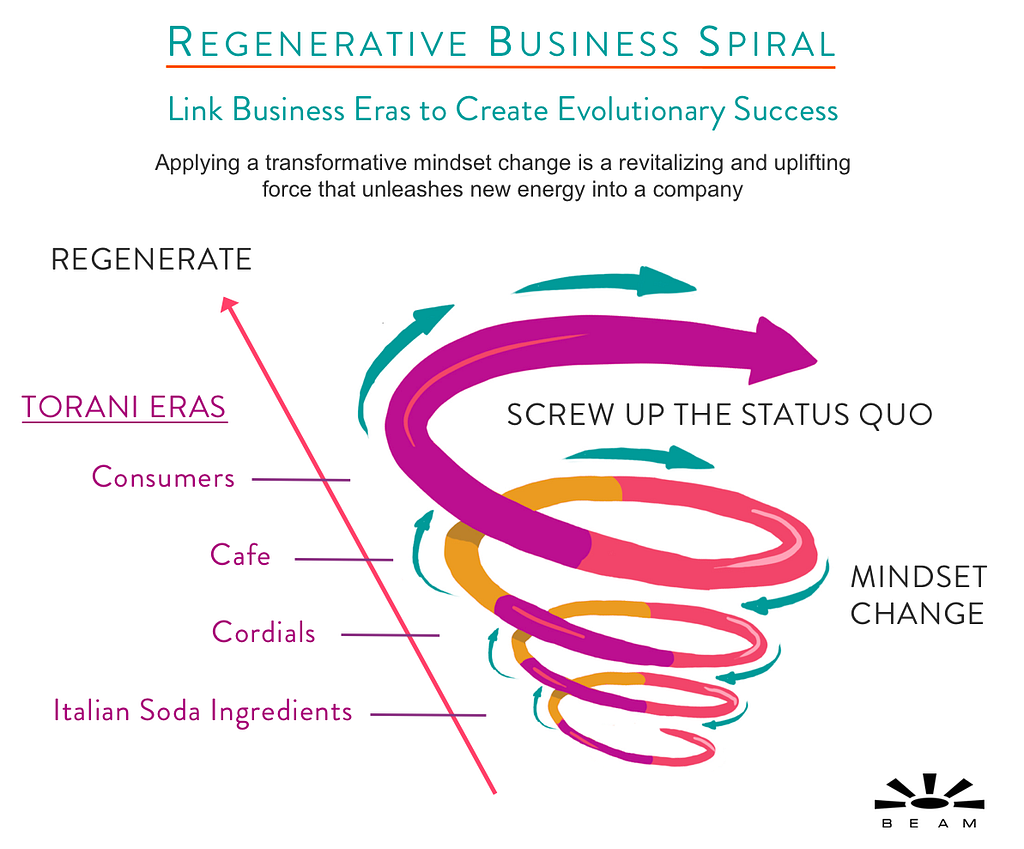B Corp Torani Takes Learning Journey to Pursue Ongoing Growth

How can you lead a reinventing, ever-regenerative company that produces valued products, is honored for best employer, operates as a socially impactful Certified B Corporation, and generates continuous profit and double-digit revenue growth year-on-year, decade-after-decade—while also continuing to grow personally and professionally?
We asked Torani’s CEO, Melanie Dulbecco, how she accomplishes this. Dulbecco’s Stanford MBA experience gave her the creative tools for strategic leadership, but beyond that she developed a deep understanding of four things that other well-educated leaders often overlook or devalue.
- Focus on what’s important. Bring alive an exciting, uniting vision built on purpose and authentic values. (“Everyone knows this.” Maybe, but not many do it well because their vision, purpose, and values are only surface deep and not strongly embedded in the culture.)
- Make it personal. Everyone must adopt a growth mindset and love-of-learning mindset in order for the company to change and grow. (“Makes sense.” But not all leaders know how to make this happen.)
- Give people the tools. Help them release individual and collective creativity that delivers on the enterprise promise. (“We give our people lots of tools.” But far too many are offered obsolete tools from the last century that don’t work today.)
- Link together a series of Regenerative Eras. This creates long-term company evolutionary success. (“Don’t most companies always try to grow over time?” Yes, but they too often fail because they try to avoid true transformative change that leads to the next upward spiral of regenerative enterprise evolution. According to McKinsey, 70% of all attempted enterprise transformations fail.)
To help other B Corps and purpose-driven businesses find success, we expand on Dulbecco’s four points and how they have propelled Torani’s people and business.
1. Focus on what’s important.
When Dulbecco, still in her early 30s, took over the leadership and management of Torani, a San Francisco-based family-owned syrup and flavor company, she first shaped a radical new vision of growth built on a strong set of beliefs and values. The vision she created, in collaboration with the company owners and top leaders, came from the heart and was drawn on a large wall chart, shared and built upon by people throughout the company. The vision was returned to over and over to embed its message deep into the culture, and it has been allowed to grow and change as the times changed. Dulbecco still displays the original vision in her office to remind everyone of the inspirations that birthed Torani’s modern era.
When it came to identifying the values that have guided the company’s growth over the years, Dulbecco and her team avoided the adoption of “off-the-shelf” character values statements seen at many companies that list qualities like integrity, respect, communication, excellence. Instead, Dulbecco and the Torani team decided to create and embed operating values into the culture that were uniquely theirs and better designed to shape Torani’s future.
Torani is part of the community of businesses that have used a third-party verification of their impact. Use the free B Impact Assessment to evaluate your company’s impact on all stakeholders, including the environment, your workers, your community and your customers.
One of the most important Torani values that Dulbecco and her team identified and deeply embedded in the culture was, “Grow, Baby, Grow.” This signaled a shift from a slow-growth, small company to an innovative, fast-growth, category-defining company of significant size and market influence.
From the beginning, growth always meant people growth as well as enterprise growth. And it was never just for growth’s sake, but growth to make positive impact in people’s lives. To be even more clear, “Grow, Baby, Grow” is not about pushing harder on the accelerator.
It is about thinking differently and continuously reinventing a creative, regenerative enterprise that is designed to move into leadership in the next new era.
And Torani growth, of course, is not about being greedy, predatory or growing without any balancing limits. It is about healthy, transformational growth that enriches life while adding value to internal and external stakeholders. In other words, it is about qualitative growth, not simply quantitative growth.
The “Grow, Baby, Grow” value resides within the Torani’s company purpose: “Flavor for all. Opportunity for all.” The purpose and values commitment to the growth of the business and the people of Torani is at the very heart of Torani’s success as it has evolved.
Dulbecco saw early on that the B Corp could grow, reinvent and transform only if the people of Torani did so first. If you don’t get the people component of change right, the other major components of change can’t take hold. Note that doesn’t mean the other factors of growth, such as strategy planning, brand building or product development are not important — they are, and Torani also did those well. But this story is about people change and its crucial role in good growth.

2. Make it personal.
When Dulbecco saw Torani was ready for a new vision for a new era of regenerative change (shifting from selling primarily in cafes to broadening the reach to consumers first through retail strategy, then in designing around consumers), she did some soul-searching to determine if she felt she were truly the right person to lead Torani into the next, unpredictable new era. She had to clearly assess her skills and abilities, envision herself in the new era, determine what it meant to her own growth, and consciously make the decision to perhaps risk personal and company success to take on a new approach to business growth. None of this is easy, but it is necessary.
“Growth and comfort do not co-exist.” — Ginni Rometty, CEO IBM
As Dulbecco had done before in making transformational change, her response was to adopt and model for her team a new mantle of courageous change leadership that would lead Torani into new and unproven territory. Making the personal mindset change needed for a new era is never comfortable. She knew that she couldn’t just tell the leadership team to make changes. She had to show, through her own leadership changes, how it could be done.
The leaders then had to demonstrate an even stronger recommitment to “Grow, Baby, Grow.” They said it was “time to get scrappy” and created what they called their “Scrappy Plan” for change. This plan consisted of holding steady and leveraging the current business model (you can’t stop the business when you are reinventing) while learning ways of operating to design a new business model.
The Torani team initiated an enterprise-wide “learning journey” to go out to meet with companies (not necessarily in the same industry) to learn firsthand from those who have been where your company wants to go. It also means meeting with “those who know secrets.” This often means learning from fellow CEOs and leaders outside your field, as well as calling upon outside consultants and experts. In the process of experiencing an enterprise-wide learning journey, you also learn about your own current limitations as well as discover the big opportunities for growing into the next era.
To be successful in this learning journey process, it is essential for leadership especially to adopt a growth and love-of-learning mindset. Regenerative leaders tend to have a strong growth mindset.
“In a growth mindset, challenges are exciting rather than threatening. So rather than thinking, ‘Oh, I’m going to reveal my weaknesses,’ you say, ‘Wow, here’s a chance to grow.’ This view creates a love of learning and a resilience that is essential for great accomplishment.”
— Carol Dweck, Stanford professor
In a world of constant change, continual learning is essential. Dulbecco is a growth mindset leader with a lifelong passion for creativity and learning. She never stops learning and believes in setting up new ways for her people to expand their learning, and the enterprise learning journey is just one of the ways. Every Torani leader is encouraged to enter a learning journey to expand professional horizons and open new stages of growth and development. In turn, they lead their people on journeys of continuous learning and development that give them the tools and perspective that prepare them for the new era. As they change, the enterprise changes.
Learning is not only about what you know; it is also about who you become. Each worthwhile learning journey changes people and prepares them for what comes next.

3. Give people the tools.
As we are pointing out, the alpha and omega of enterprise regeneration is the change and growth of people. Enterprise change begins with people changing and ends with them leading the enterprise into exciting new territory.
The true mission of all entrepreneurial leaders is to unleash the collective power and creativity of people to create enterprise value and enrich life for the people who build the enterprise, for the people they serve, their investors, the enterprise itself and all who are affected by their work and social impact.
Before you can start to reinvent the enterprise for success, you first have to screw up the status quo with your people. This means you have to help them break old patterns of thinking and operating. This is not easy because it forces everyone to experience both enterprise and personal discomfort.
People often think, “If I let go of what has made me successful, what will I have left? How will I know I can operate in new ways and again be successful?”
To help people to get beyond this discomfort and prepare for success in a new era, Torani developed a Manager’s Tool Kit. Building on the work of the learning journey system, the tool kit includes contribution management and career mixology.
Contribution Management
Torani found the traditional performance management systems inadequate for “Grow, Baby, Grow.” They were too focused on evaluations of the past and not enough on growth contributions to the future.
Torani’s contribution management system primarily focuses on the individual owning their own growth, with the manager’s guidance and support. They outline what they will contribute to future enterprise success and focus on how they will learn, develop and innovate to grow their contribution. This is a continual process of planning contribution multiple times throughout the year with their manager.
Career Mixology
Mixing new ingredients in new ways creates new flavors (“Flavor for All, Opportunity for All”). Torani’s career mixology system provides cross-discipline learning and role switches that flex the growth mindset, diversify skill sets, refresh the individual, and create a new effectiveness mix in the organization. For example, a person working in production may move over to marketing or selling to expand their learning and career possibilities. In turn they bring new insights to their new area of contribution, creating a win-win for all.
4. Link together a series of regenerative eras.
In her time as CEO, Dulbecco has led Torani through several regenerative growth eras that link together to create total enterprise evolutionary success. In taking Torani from less than $1 million in revenue to hundreds of millions, Dulbecco led the company from the cordials era into the market-changing café era (no one was using syrups and flavorings in coffee drinks at the time) and then into the next big-growth consumer era.
At each of these big-leap era changes, the Torani leaders, teams, and the enterprise itself had to go through a reinvention—a regenerative loop of transformation. It takes more than small adjustments to make leaps to a new era. You have to:
- Screw up the status quo and let go of old operating patterns.
- Make a conscious mindset change.
- Redesign and Regenerate with a strong surge of creativity and innovation throughout the enterprise.
This requires a courageous change of, not just a small change in, the enterprise. Programmatic changes in organizations rarely make significant enough change and are often killed or diminished by the mainstream business they are trying to change. Each regenerative era change requires a true change of the enterprise, leadership and the culture. The model below shows the “change of” regenerative transformation loop pattern:

Linking together each of the regenerative eras of growth creates an upward spiral of enterprise evolution that builds a pattern of long-term success. (For more insights on the regenerative enterprise, check out our blog, Being Regenerative: Your Key to Flourishing in the Future.)

Note: For the purposes of this article, we are focusing only on the people aspect of regeneration. Torani, as a B Corp, factors the full array of people, planet and profit benefits into its regeneration design and execution.
A Regenerative Environment Is Essential
People want their work to be purposeful, creative, and fulfilling, and they want to have fun doing it. They want to be a part of collective regenerative success. And they need a regenerative environment that reinforces and enables this.
If there is one thing you feel walking through the Torani facilities and offices, it is a strong sense of creative energy and fun. People are open, alive, and always moving and everything around you is colorful and surprising. For example, in their big gathering room there is a little Italian car parked next to a bright artful mural next to a full café-environment tasting area, open for everyone to experiment and try out new product ideas. This is indicative of the energy of the company, always filled with creative experimentation, surprising experiences, as well as engaging contests and celebrations.
The Torani environment reflects its brand and Dulbecco’s positive “screw up the status quo” personality and her strong belief in bringing out the creative potential and opportunity residing in everyone.
This people-based belief extends into Torani’s many social impact programs and creative activities with youth, schools, and community. These are now evolving to become a part of the outward expression and integration of “opportunity for all.”
The Dulbecco and Torani story is an example of how the best of companies are creatively developing better ways to grow in this emerging new era of continuous regeneration. As consultants to Dulbecco and Torani over the changing eras, as well as with numerous other small to major multinational companies, we’ve learned at BEAM, inc just how rare it is that leaders truly understand the importance and power of people-centric enterprise transformation.
Moral of the Story
When your purpose (“Flavor for All, Opportunity for All”) is in the DNA of your enterprise, it positively impacts everyone and everything.
When a strong, embedded value (“Grow Baby Grow”) is core to your success, it drives your future decisions and actions.
And when you commit to building an ever-regenerative, people-centered enterprise, you can create amazing results.
Written by BEAM, inc, a San Francisco-based international consulting and design firm dedicated to creating value and enriching life for our clients and their stakeholders through transformation and innovation.
B the Change gathers and shares the voices from within the movement of people using business as a force for good and the community of Certified B Corporations. The opinions expressed do not necessarily reflect those of the nonprofit B Lab.

A Better Way to Grow: The Ever-Regenerative, People-Centered Enterprise was originally published in B the Change on Medium, where people are continuing the conversation by highlighting and responding to this story.